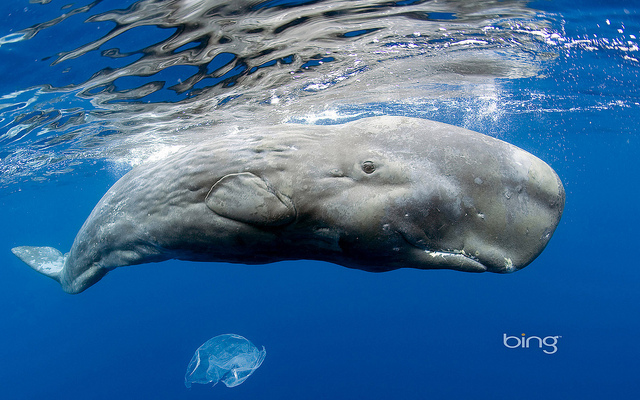Sperm whale; photo by Szecska on Flickr (noncommercial use permitted with attribution / share alike).
Official State Animal of Connecticut
Connecticut designated the sperm whale (Physeter macrocephalus) the official state animal in 1975. All State Mammals - All Aquatic Life Symbols
The sperm whale played a significant role in the history of Connecticut (in the 1800's Connecticut ranked second only to Massachusetts in the whaling industry). The sperm whale is now on the federal endangered species list.
The largest of the toothed whales, sperm whales grow to 70 feet in length and can weigh 59 tons. The brain of the sperm whale is the largest of any animal (reaching up to 20 pounds). The sperm whale was immortalized as Herman Melville's leviathan "Moby Dick."
Among whales, the sperm whale is unique in both appearance and social behavior. The enormous box- like head sets it apart physically from other whales. Females and their young travel in permanent units (pods), while the much larger males rove between breeding and feeding grounds, and also among groups of females when breeding. Sperm whales are among the deepest diving cetaceans, capable of diving two miles in search of deep water squid, their main food source (a sperm whale consumes about one ton of food each day - squid, fish, skate, octopus, etc.). Sperm whales can be found in all oceans of the world.
Members of a whale pod form strong and long lasting bonds. They protect young calves and the sick or injured of their pod. Other females protect a calf that is not yet capable of deep diving while the mother dives for food.
From Sperm Whale: American Cetacean Society Fact Sheet:
The sperm whale's head houses a large reservoir containing spermaceti, a clear liquid oil that hardens to a wax- like consistency when cold, and has long been prized by whalers. Ambergris (a strange substance found in large lumps in the lower intestine of sperm whales, formed around squid beaks that remain in the stomach) was used in the making of perfume, and continues to be valuable in spite of its widespread replacement by synthetics.
Sperm whales are still fairly numerous, but selective killing of the larger breeding-age males over many years upset the male-to-female ratio, and the birth rate has seriously declined in some populations. Sperm whales were killed in two massive hunts, the Moby Dick whalers who worked mainly between 1740-1880, and the modern whalers whose operations peaked in 1964, when 29,255 were killed. Most recent estimates suggest a global population of about 360,000 animals down from about 1,100,000 before whaling.


